土木工程专业英语(苏小卒版)翻译.
土木工程专业英语课文翻译考试必备
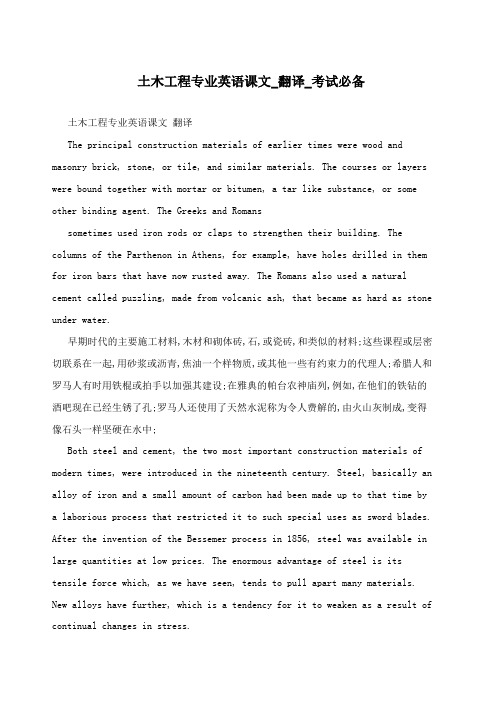
土木工程专业英语课文_翻译_考试必备土木工程专业英语课文翻译The principal construction materials of earlier times were wood and masonry brick, stone, or tile, and similar materials. The courses or layers were bound together with mortar or bitumen, a tar like substance, or some other binding agent. The Greeks and Romanssometimes used iron rods or claps to strengthen their building. The columns of the Parthenon in Athens, for example, have holes drilled in them for iron bars that have now rusted away. The Romans also used a natural cement called puzzling, made from volcanic ash, that became as hard as stone under water.早期时代的主要施工材料,木材和砌体砖,石,或瓷砖,和类似的材料;这些课程或层密切联系在一起,用砂浆或沥青,焦油一个样物质,或其他一些有约束力的代理人;希腊人和罗马人有时用铁棍或拍手以加强其建设;在雅典的帕台农神庙列,例如,在他们的铁钻的酒吧现在已经生锈了孔;罗马人还使用了天然水泥称为令人费解的,由火山灰制成,变得像石头一样坚硬在水中;Both steel and cement, the two most important construction materials of modern times, were introduced in the nineteenth century. Steel, basically an alloy of iron and a small amount of carbon had been made up to that time by a laborious process that restricted it to such special uses as sword blades. After the invention of the Bessemer process in 1856, steel was available in large quantities at low prices. The enormous advantage of steel is its tensile force which, as we have seen, tends to pull apart many materials. New alloys have further, which is a tendency for it to weaken as a result of continual changes in stress.钢铁和水泥,两个最重要的现代建筑材料,介绍了在十九世纪;钢,铁,基本上是少量的碳合金已作出了这一由一个艰苦的过程,限制它的刀刃等特殊用途的时间;后在1856年发明贝塞麦过程,钢在低价格大批量供货;钢铁的巨大优势是它的拉伸力,正如我们所看到的,往往会拉开许多材料;新合金进一步,这是一个趋势,它削弱了在压力不断变化的结果;Modern cement, called Portland cement, was invented in 1824. It is a mixture of limestone and clay, which is heated and then ground into a power. It is mixed at or near the construction site with sand, aggregate small stones, crushed rock, or gravel, and water to make concrete. Different proportions of the ingredients produce concrete with different strength and weight. Concrete is very versatile; it can be poured, pumped, or even sprayed into all kinds of shapes. And whereas steel has great tensile strength, concrete has great strength under compression. Thus, the two substances complement each other. 现代水泥,称为硅酸盐水泥,发明于1824年;它是石灰石和粘土的混合物,被加热,然后进入电源地;它是混合达到或接近沙施工现场,聚集的小石头,碎石,或石子和水,使混凝土;不同比例的成分产生不同强度和重量混凝土;混凝土是非常灵活,它可浇,泵浦,或连成各种形状喷洒;和鉴于钢具有很大的拉伸强度,混凝土受压的伟大力量;因此,这两种物质是相辅相成的;They also complement each other in another way: they have almost the same rate of contraction and expansion. They therefore can work together in situations where both compression and tension are factors. Steel rods are embedded in concrete to make reinforced concrete in concrete beams or structures where tensions will develop. Concrete and steel also form such a strong bond the force that unites them that the steel cannot slip within theconcrete. Still another advantage is that steel does not rust in concrete. Acid corrodessteel, whereas concrete has an alkaline chemical reaction, the oppositeof acid.他们还以另一种方式补充对方:他们几乎在同样的速度收缩和扩张;因此,他们可以一起工作的情况下压缩和紧张的因素;钢条是嵌在混凝土,使钢筋混凝土结构中混凝土梁或地方的紧张局势会发展;混凝土和钢也形成如此强烈的纽带团结的力量他们的钢材,不滑内的混凝土;还有一个好处是,不生锈的钢混凝土;酸腐蚀钢,而混凝土的碱性化学反应,酸相反;The adoption of structural steel and reinforced concrete caused major changes in traditional construction practices. It was no longer necessary to use thick walls of stone or brick for multistory buildings, and it became much simpler to build fire-resistant floors. Both these changes served to reduce the cost of construction. It also became possible to erect buildings with greater heights and longer spans.结构钢和钢筋混凝土建筑采用传统的做法造成了重大变化;它不再需要使用的石块或砖头厚的多层建筑物的墙壁,成为更简单,建立防火地板;这些变化都有助于降低建设成本;它也成为可能有更大的直立高度和时间跨度的建筑;Since the weight of modern structures is carried by the steel or concrete frame, the walls do not support the building. They have become curtain walls, which keep out the weather and let in light. In the earlier steel orconcrete frame building, the curtain walls were generally made of masonry; they had the solid look of bearing walls. Today, however, curtain walls are often made of lightweight materials such as glass, aluminum, or plastic, in various combinations. 由于现代结构重量是由钢或混凝土框架进行,墙壁不支持建设;他们已成为玻璃幕墙,它保持了天气和光线让;在早期的钢或混凝土框架结构,玻璃幕墙,一般由砖石,他们有坚实的承重墙看看;然而,今天,玻璃幕墙往往是由诸如玻璃,铝,塑料或轻质材料,在各种组合;Another advance in steel construction is the method of fastening together the beams. For many years the standard method was riveting. A rivet is abolt with a head that looks like a blunt screw without threads. It is heated, placed in holes through the pieces of steel, and a second head is formed at the other end by hammering it to hold it in place. Riveting has now largely been replaced by welding, thejoining together of pieces of steel by melting a steel material between them under high heat.钢结构建筑的另一个进步是梁紧固在一起的方法;多年来,标准方法是铆;铆钉是一个头,像一个没有线程看起来钝螺丝螺栓;它被加热时,通过放置在洞的钢件,第二头在另一端形成的锤击它举行到位;铆接现在很大程度上是由焊接取代,加入钢件在一起融化在高温下它们之间的钢铁材料;Presstressed concrete is an improved form of reinforcement. Steel rodsare bent into the shapes to give them the necessary degree of tensile strengths. They are then used to priestess concrete, usually by one of two different methods. The first is to leave channels in a concrete beam that correspond to the shapes of the steel rods. When the rods are run throughthe channels, they are then bonded to the concrete by filling the channels with grout, a thin mortar or binding agent. In the other and more common method, the priestesses steel rods are placed in the lower part of a formthat corresponds to the shape of the finished structure, and the concrete is poured around them. Priestess’s concrete uses less steel and less concrete. Because it is a highly desirable material.预应力钢筋混凝土是一种改进形式;棒钢弯曲成的形状,给他们一定程度的拉伸强度;然后他们用女祭司混凝土,由两种不同的方法之一,通常;首先是留在渠道混凝土梁对应于钢铁棒的形状;当棒是通过渠道来说,他们是那么粘在混凝土充填灌浆,薄砂浆或结合剂的渠道;在其他更常见的方法,女祭司钢棒放置在一个表格对应的成品下部结构形状,和他们周围的混凝土浇;女祭司的具体使用较少的钢铁和混凝土少;因为它是一个非常可取的材料;Presstressed concrete has made it possible to develop buildings with unusual shapes, like some of the modern, sports arenas, with large spaces unbroken by any obstructing supports. The uses for this relatively new structural method are constantly being developed. 预应力混凝土使人们有可能发展不寻常的形状的建筑物,如现代,体育场一些大空间的任何阻挠支持不间断;在使用这种相对较新的构造方法正在不断发展;。
土木工程专业英语(苏小卒)课文翻译13、15、17、18单元

土木工程专业英语(苏小卒)课文翻译13、15、17、18单元Unit 13 第十三单元Survey测量教学目标了解测量的内容、方法、范围和原理了解常用的测量类型熟悉各种测量方法和类型的词汇熟悉科技类文献的常用句型熟悉map、chart、plot、construction、draw的含义;so far、heretofore、by far的含义;have to do with、be referred to、be related to的含义;compatible with、pertain to 、application to 的含义;;layout、staking out 的含义;construction 的不同含义。
Surveying has to do with(与..有关)the determination of the relative spatial location(相对空间位置)of points on or near the surface of the earth. It is the art(技术)of measuring horizontal and vertical distance between objects, of measuring angles between lines, of determining the direction of lines, and of establishing points by predetermined angularand linear measurements(角测量法和线性测量法).测量是关于确定地球表面上或接近地球表面的点的相对空间位置。
它是测量物体之间水平与垂直距离、测量线条之间夹角、确定线条方向以及通过预先确定角测量法和线性测量法来建立点的技术。
Accompanying the actual measurement(度量)of survey are mathematical calculations. Distance, angles, directions, locations, elevations, areas, and volumes are thus determined from data of survey. Also, much of the information of the survey is portrayed graphically(图示描述)by the construction of maps, profiles(纵剖面图), cross sections(横剖面图), and diagrams(图表).数学计算伴随着测量中的实际量度。
土木工程专业英语(苏小卒版)翻译.
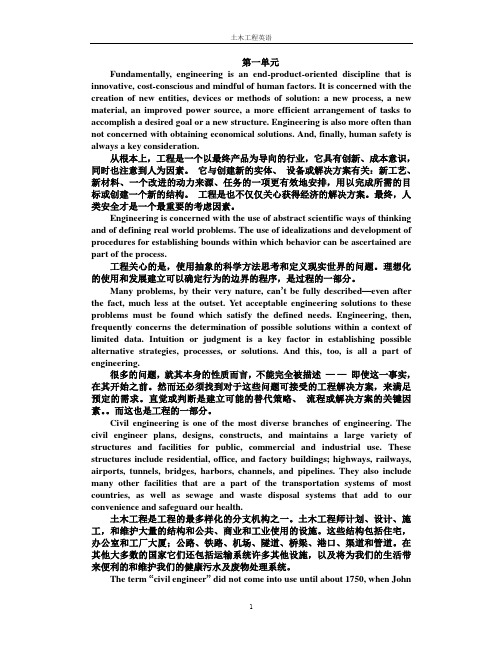
第一单元Fundamentally, engineering is an end-product-oriented discipline that is innovative, cost-conscious and mindful of human factors. It is concerned with the creation of new entities, devices or methods of solution: a new process, a new material, an improved power source, a more efficient arrangement of tasks to accomplish a desired goal or a new structure. Engineering is also more often than not concerned with obtaining economical solutions. And, finally, human safety is always a key consideration.从根本上,工程是一个以最终产品为导向的行业,它具有创新、成本意识,同时也注意到人为因素。
它与创建新的实体、设备或解决方案有关:新工艺、新材料、一个改进的动力来源、任务的一项更有效地安排,用以完成所需的目标或创建一个新的结构。
工程是也不仅仅关心获得经济的解决方案。
最终,人类安全才是一个最重要的考虑因素。
Engineering is concerned with the use of abstract scientific ways of thinking and of defining real world problems. The use of idealizations and development of procedures for establishing bounds within which behavior can be ascertained are part of the process.工程关心的是,使用抽象的科学方法思考和定义现实世界的问题。
(完整版)土木工程专业英语翻译
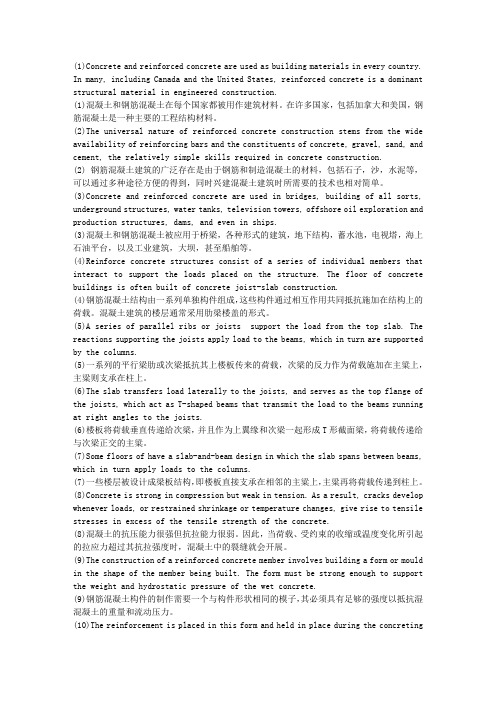
(1)Concrete and reinforced concrete are used as building materials in every country. In many, including Canada and the United States, reinforced concrete is a dominant structural material in engineered construction.(1)混凝土和钢筋混凝土在每个国家都被用作建筑材料。
在许多国家,包括加拿大和美国,钢筋混凝土是一种主要的工程结构材料。
(2)The universal nature of reinforced concrete construction stems from the wide availability of reinforcing bars and the constituents of concrete, gravel, sand, and cement, the relatively simple skills required in concrete construction.(2) 钢筋混凝土建筑的广泛存在是由于钢筋和制造混凝土的材料,包括石子,沙,水泥等,可以通过多种途径方便的得到,同时兴建混凝土建筑时所需要的技术也相对简单。
(3)Concrete and reinforced concrete are used in bridges, building of all sorts, underground structures, water tanks, television towers, offshore oil exploration and production structures, dams, and even in ships.(3)混凝土和钢筋混凝土被应用于桥梁,各种形式的建筑,地下结构,蓄水池,电视塔,海上石油平台,以及工业建筑,大坝,甚至船舶等。
(完整版)土木工程专业英语翻译
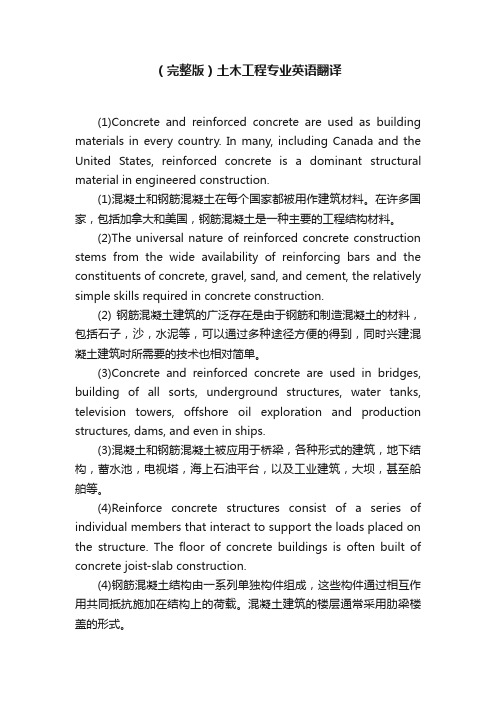
(完整版)土木工程专业英语翻译(1)Concrete and reinforced concrete are used as building materials in every country. In many, including Canada and the United States, reinforced concrete is a dominant structural material in engineered construction.(1)混凝土和钢筋混凝土在每个国家都被用作建筑材料。
在许多国家,包括加拿大和美国,钢筋混凝土是一种主要的工程结构材料。
(2)The universal nature of reinforced concrete construction stems from the wide availability of reinforcing bars and the constituents of concrete, gravel, sand, and cement, the relatively simple skills required in concrete construction.(2) 钢筋混凝土建筑的广泛存在是由于钢筋和制造混凝土的材料,包括石子,沙,水泥等,可以通过多种途径方便的得到,同时兴建混凝土建筑时所需要的技术也相对简单。
(3)Concrete and reinforced concrete are used in bridges, building of all sorts, underground structures, water tanks, television towers, offshore oil exploration and production structures, dams, and even in ships.(3)混凝土和钢筋混凝土被应用于桥梁,各种形式的建筑,地下结构,蓄水池,电视塔,海上石油平台,以及工业建筑,大坝,甚至船舶等。
土木工程专业英语翻译

Lesson One Civil Engineering1Civil engineering, the oldest of the engineering specialties, is the planning, design, construction and management of the built environment. This environment includes all structures built according to scientific principles, from irrigation and drainage systems to rocket-launching facilities.1土木工程学土木工程学作为最老的工程技术学科,是指规划,设计,施工及对建筑环境的管理。
此处的环境包括建筑符合科学规范的所有结构,从灌溉和排水系统到火箭发射设施。
2Civil engineers build roads, bridges, tunnels, dams, harbors, power plants, water and sewage systems, hospitals, schools, mass transit, and other public facilities essential to modern society and large population concentrations. They also build privately owned facilities such as airports, railroads, pipelines, skyscrapers, and other large structures designed for industrial, commercial, or residential use. In addition. civil engineers plan, design, and build complete cities and towns, and more recently have been planning and designing space platforms to house self-contained communities.2土木工程师建造道路,桥梁,管道,大坝,海港,发电厂,给排水系统,医院,学校,公共交通和其他现代社会和大量人口集中地区的基础公共设施。
高等教育土木工程专业英语上册翻译苏小卒编同济大学

[高等教育]土木工程专业英语上册翻译苏小卒编同济大学本课程介绍在学习普通英语(包括常用词汇和语法结构)的基础上,接合前几个学期已经掌握的关于土木工程的专业知识,本课程节选了《土木工程专业英语》上册中的内容,涉及建筑材料、材料力学、结构力学、钢筋混凝土结构、钢结构、测量、土力学、招投标、建筑施工等九个方面的专业英语知识,从而使大家对土木工程领域内的专业词汇以及科技类文献中的常用句型有个初步的、基本的学习和了解,为以后查阅专业文献和参与国际交流打好基础。
第三单元The principal construction materials of earlier times were wood and masonry-brick, stone, or tile, and similar materials. The courses or layers(砖层)were bound together with mortar or bitumen, a tarlike substance, or some other binding agent. The Greeks and Romans sometimes used iron rods or clamps to strengthen their building. The columns of the Parthenon in Athens(雅典的帕台农神庙), for example, have holes drilled(钻孔) in them for iron bars that have now rusted away(锈蚀殆尽). The Romans also used a natural cement called pozzolana, made from volcanic ash, that became as hard as stone under water.早期主要的建筑材料是木材和砌体,如砖、石、瓦以及类似的材料。
土木工程专业英语课文原文及对照翻译
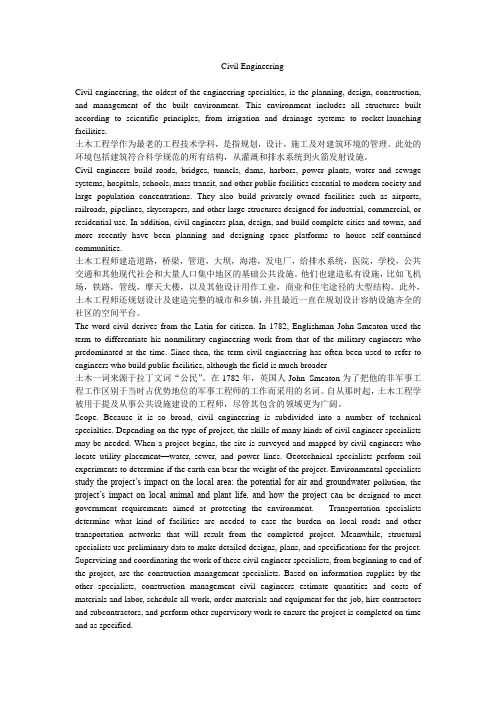
Civil EngineeringCivil engineering, the oldest of the engineering specialties, is the planning, design, construction, and management of the built environment. This environment includes all structures built according to scientific principles, from irrigation and drainage systems to rocket-launching facilities.土木工程学作为最老的工程技术学科,是指规划,设计,施工及对建筑环境的管理。
此处的环境包括建筑符合科学规范的所有结构,从灌溉和排水系统到火箭发射设施。
Civil engineers build roads, bridges, tunnels, dams, harbors, power plants, water and sewage systems, hospitals, schools, mass transit, and other public facilities essential to modern society and large population concentrations. They also build privately owned facilities such as airports, railroads, pipelines, skyscrapers, and other large structures designed for industrial, commercial, or residential use. In addition, civil engineers plan, design, and build complete cities and towns, and more recently have been planning and designing space platforms to house self-contained communities.土木工程师建造道路,桥梁,管道,大坝,海港,发电厂,给排水系统,医院,学校,公共交通和其他现代社会和大量人口集中地区的基础公共设施。
- 1、下载文档前请自行甄别文档内容的完整性,平台不提供额外的编辑、内容补充、找答案等附加服务。
- 2、"仅部分预览"的文档,不可在线预览部分如存在完整性等问题,可反馈申请退款(可完整预览的文档不适用该条件!)。
- 3、如文档侵犯您的权益,请联系客服反馈,我们会尽快为您处理(人工客服工作时间:9:00-18:30)。
第一单元Fundamentally, engineering is an end-product-oriented discipline that is innovative, cost-conscious and mindful of human factors. It is concerned with the creation of new entities, devices or methods of solution: a new process, a new material, an improved power source, a more efficient arrangement of tasks to accomplish a desired goal or a new structure. Engineering is also more often than not concerned with obtaining economical solutions. And, finally, human safety is always a key consideration.从根本上,工程是一个以最终产品为导向的行业,它具有创新、成本意识,同时也注意到人为因素。
它与创建新的实体、设备或解决方案有关:新工艺、新材料、一个改进的动力来源、任务的一项更有效地安排,用以完成所需的目标或创建一个新的结构。
工程是也不仅仅关心获得经济的解决方案。
最终,人类安全才是一个最重要的考虑因素。
Engineering is concerned with the use of abstract scientific ways of thinking and of defining real world problems. The use of idealizations and development of procedures for establishing bounds within which behavior can be ascertained are part of the process.工程关心的是,使用抽象的科学方法思考和定义现实世界的问题。
理想化的使用和发展建立可以确定行为的边界的程序,是过程的一部分。
Many problems, by their very nature, can’t be fully described—even after the fact, much less at the outset. Yet acceptable engineering solutions to these problems must be found which satisfy the defined needs. Engineering, then, frequently concerns the determination of possible solutions within a context of limited data. Intuition or judgment is a key factor in establishing possible alternative strategies, processes, or solutions. And this, too, is all a part of engineering.很多的问题,就其本身的性质而言,不能完全被描述——即使这一事实,在其开始之前。
然而还必须找到对于这些问题可接受的工程解决方案,来满足预定的需求。
直觉或判断是建立可能的替代策略、流程或解决方案的关键因素。
而这也是工程的一部分。
Civil engineering is one of the most diverse branches of engineering. The civil engineer plans, designs, constructs, and maintains a large variety of structures and facilities for public, commercial and industrial use. These structures include residential, office, and factory buildings; highways, railways, airports, tunnels, bridges, harbors, channels, and pipelines. They also include many other facilities that are a part of the transportation systems of most countries, as well as sewage and waste disposal systems that add to our convenience and safeguard our health.土木工程是工程的最多样化的分支机构之一。
土木工程师计划、设计、施工,和维护大量的结构和公共、商业和工业使用的设施。
这些结构包括住宅,办公室和工厂大厦;公路、铁路、机场、隧道、桥梁、港口、渠道和管道。
在其他大多数的国家它们还包括运输系统许多其他设施,以及将为我们的生活带来便利的和维护我们的健康污水及废物处理系统。
The term “civil engineer” did not come into use until about 1750, when JohnSmeaton, the builder of famous Eddystone lighthouse near Plymouth, England, is said to have begun calling himself a “civil engineer” to distinguish himself from the military engineers of his time. However, the profession is as old as civilization.直到大约1750年,人们才开始使用“土木工程师”这一术语。
约翰.斯密顿在英格兰普利茅斯附近,建造了著名的埃迪斯通灯塔的建造师,开始自称为“土木工程师"来将自己与当时的军事工程师区分开。
然而,土木工程这个职业却像文明一样古老。
In ancient Egypt the simplest mechanical principles and devices were used to construct many temples and pyramids that are still standing, including the great pyramid at Giza and the temple of Amon-Ra at Karnak. The great pyramid, 481 feet(146.6 meters)high, is made of 2.25 million stone blocks having an average weight of more than 1.5tons (1.4 metric tons). Great numbers of men were used in the construction of such monuments. The Egyptians also made obelisks by cutting huge blocks of stone, some weighing as much as 1000 tons (900 metric tons). Cutting tools of hard bronze were used.古埃及人用最简单的机械原理和装置建造了许多至今仍矗立的庙宇和金字塔,包括吉萨大金字塔和在卡纳克的Amon-Ra的寺庙。
这个大金字塔,481英尺(146.6 米)高,由2250000个石块组成,石块的平均重量超过1.5吨(1.4 吨)。
建造如此的纪念性建筑使用了大量的人力。
埃及人也作了一些重达1000吨(900吨)的石头的大块切割的方尖塔。
硬青铜的切削刀具在其中使用到了。
The Egyptians built causeways and roads for transporting stone from the quarries to the Nile. The large blocks of stone that were erected by the Egyptians were moved by using levers, inclined planes, rollers, and sledges.为了从采石场向尼罗河运输石材埃及人建造了长堤和道路。
由埃及人竖设的大块石头通过使用拉杆、斜平面、滚子和雪橇来移动。
The Egyptians were primarily interested in the know-how of construction; They had very little interest in why-for of use .In contrast, the Greeks made great strides in introducing theory into engineering problems during the 6th to 3rd centuries B.C. They developed an abstract knowledge of lines, angles, surfaces, and solids rather than referring to specific objects. The geometric base for Greek building construction included figures such as the square, rectangle, and triangle.埃及人主要对如何建造感兴趣;他们对为什么这么使用没有什么太多的兴趣。
相反,在公元前六世纪到公元前三世纪希腊人取得了巨大的进步于工程理论的推广。
他们发展了线、角度、面,和实体的抽象的知识,而不是与特定的对象产生联系。
希腊建筑施工的几何基础包括数字如正方形、矩形和三角形。
